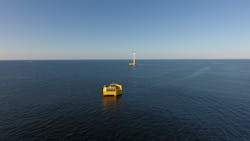DNV investigating risks of offshore hydrogen facilities
Offshore staff
OSLO, Norway – DNV will lead a study assessing the main environmental, safety, and operational risks for what is claimed will be the world’s first offshore hydrogen production facility.
The green hydrogen-generating system off the coast of Le Croisic, France, is due to be powered by electricity from a floating wind turbine, with a projected start-up in 2022.
The developers are Lhyfe, a producer and supplier of green and renewable hydrogen for transport and industry, and Centrale Nantes, a French school of engineering and research center, which also manages the SEM-REV offshore test site.
Their main goal is to demonstrate the reliability of an offshore electrolyser, which will be installed on GEPS Techno’s floating platform and connected to various sources of marine renewable energy available on the offshore test site, including the Floatgen floating wind turbine. The process only emits oxygen, with no CO2, during operation.
DNV’s team will organize workshops and technical sessions to identify and analyze the project’s risks, such as the floating barge, fuel cells, and hydrogen production. A regulations and standards review will also be included as part of the study.
Centrale Nantes is also making its research facilities available and assisting the various regulatory, experimental, and logistical phases.
07/15/2021
